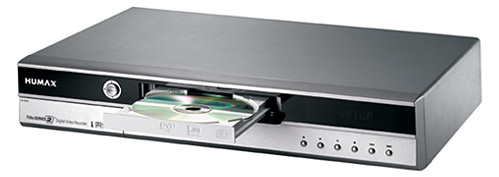
I purchased the Humax DRT-800 combination TiVo and DVD player/burner a little under 3 months ago and have been using the unit constantly since then. I have intended on writing a review for a while now, so I'm finally getting around to that, sorry for the hold up!
I've only read one other comprehensive review of the Humax DRT-800, and most of it talked about TiVo features that are on all TiVo units. In this review, I thought I'd talk mostly about the additional features that the DRT-800 has over and above all regular TiVo units, although I will touch briefly on the DRT-800's support for normal TiVo functionality for those who aren't as familiar with it.
TiVo, as most know by now, records programs off of TV like a VCR, but it records the digital bits of a show as a file onto a hard drive inside the unit as opposed to an analog tape. TiVo's are basically computers running the Linux operating system with a video capture card and a hard drive. Special software provides the TiVo interface that allows you to record shows automatically based on preferences you set manually and/or the unit learns based on what you record. You can record whole seasons of shows and if it changes its schedule (permanently or temporarily) the TiVo will know, and change its recording schedule accordingly. It does this by continually downloading a schedule of upcoming programs over a phone line or an Internet connection. The DRT-800 contains TiVo with all the functionality that a stand-alone series 2 TiVo has, although no TiVo ToGo yet (which I'll cover later).
As for the TiVo functionality of the DRT-800, I've only had one issue with recording regular programs. I've noticed a number of times that while watching a recorded show, the screen would go blank (actually grey) for an instant, and then come back on. This might happen once or twice during a show, or not at all. I thought perhaps my unit was defective, so I called Humax and they suggested a reboot. This seemed to solve the problem but then I noticed it again a few days later. My wife determined that it corresponds to turning my TV on and off. I haven't confirmed this yet, and I've not seen anyone else yet to report a similar issue, so it may just be an odd combination of my particular TV and perhaps a DRT-800 with a special issue… Others online have talked about having problems with "crushed blacks" (no detail in shadows) and lots of digital artifacts even at the highest recording quality setting. But some of this may be the fault of the output connection. Using an S-Video cable instead of a composite seems to clean up a lot of problems. I myself haven't noticed anything terrible, but I am using S-Video and this is also my first TiVo, so I can't really compare it to anything other than live TV. The picture quality is undoubtedly worse than live TV, but then I have a very nice 34" high definition Sony CRT with a DirectTV satellite receiver, so even at standard definition, my picture is extremely good. Taking this signal and converting it to analog and back to digital is going to wreak at least some havoc!
DVD Player
 The DRT-800 has a DVD player/burner in it, and you can use it to play all your regular movie DVD's. It has progressive scan for those with high-definition displays, and a high-quality component output for your TV. Because it doubles as a DVD player, this means you can save space and wires that would normally be devoted to a completely separate DVD player unit. There are, however, a couple of disadvantages to using the DRT-800 as your DVD player. One minor one is that in order to play a DVD, you need to go through the TiVo environment, instead of just being able to plop it in and hit play (or just letting it play by default). A more annoying issue, though, is the fact that the remote that comes with the TiVo, does not have a lot of the buttons that you would find on a stand-alone DVD player. It has an angle button and a menu and top menu button, but no subtitle button, nor an audio button, and it's track forward and back functions are unintuitively assigned to the channel up/down button. This is not a HUGE deal, but it still would have been nice to have a full compliment of buttons for the DVD player function.
The DRT-800 has a DVD player/burner in it, and you can use it to play all your regular movie DVD's. It has progressive scan for those with high-definition displays, and a high-quality component output for your TV. Because it doubles as a DVD player, this means you can save space and wires that would normally be devoted to a completely separate DVD player unit. There are, however, a couple of disadvantages to using the DRT-800 as your DVD player. One minor one is that in order to play a DVD, you need to go through the TiVo environment, instead of just being able to plop it in and hit play (or just letting it play by default). A more annoying issue, though, is the fact that the remote that comes with the TiVo, does not have a lot of the buttons that you would find on a stand-alone DVD player. It has an angle button and a menu and top menu button, but no subtitle button, nor an audio button, and it's track forward and back functions are unintuitively assigned to the channel up/down button. This is not a HUGE deal, but it still would have been nice to have a full compliment of buttons for the DVD player function.
DVD Burner
The DVD drive in the DRT-800 functions not only to PLAY DVD's, but also to BURN them, and this is where the unit really earns it's extra value. The main thing that people will use this feature for is to burn programs that they've recorded with the TiVo itself, but there are other things you can burn as well, as I will explain.
Before talking about the actual process of burning a program to DVD, I thought I'd write a little about DVD formats that are used by the DRT-800 and what this means in a practical sense to the user. The DRT-800 can burn DVD "recordables" (write can only be written to once and never erased) and DVD "rewritables" (which you can write to and erase from much like a VHS tape or floppy disk). You can't just by any recordable or rewritable format. For recordables, you have to use discs labeled DVD-R, and for rewritabled, it's DVD-RW. You can pick up DVD-R's for as cheap as $.25 per DVD on sale, but DVD-RW's are often much more expensive – maybe $1.50 per disc at the cheapest? So why would you even bother with DVD-RW's? I wouldn't myself, except that I've found that it's nice to have some on hand to record stuff that you know you only need for a short period of time. And the reason you might want some temporary storage space? Well, the DRT-800 comes with an 80GB hard drive that is rated at "80 hours" of playback. But like all TiVo's, this 80 hours is a somewhat disengenous claim, because it is only valid when using the TiVo's poorest quality level. At the best quality level, it's closer to 18 hours for the DRT-800. You'd be surprised at how fast this can fill up if you record even a handful of shows each week at the best quality level. Get busy for several days and the hard drive gets so full that your programs start being deleted in order to make room for new ones! One solution is to upgrade your hard drive through one of the services that either do this themselves or will sell you a kit, like Weaknees or ptvupgrade. But this can cost an additional $200 or more over the already $400 you probably spent on the DRT-800. So, getting ten DVD-RW discs automatically expands your effective capacity from 18 hours at best quality to 28 hours, as you are able to offload some of the programs onto disc.
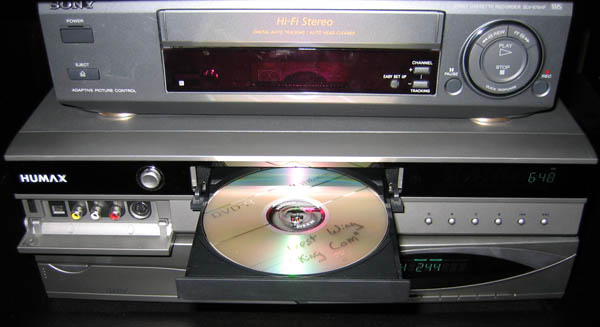
Ok, so how exactly does recording to DVD work? In order to burn a program on the TiVo to disc, you can do it a couple of ways. You choose the dvd recorder from the main TiVo menu, click on Save Programs to DVD, at which point you are presented with a convenient list of all your programs and how much space they will take up on the DVD.
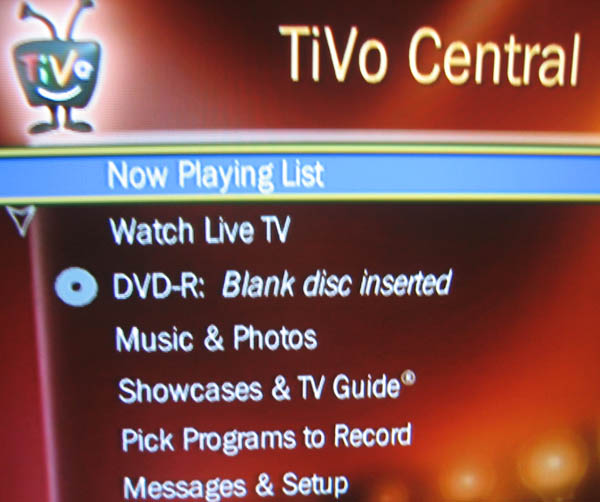
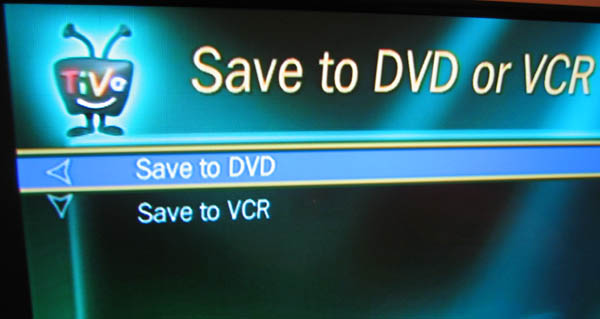
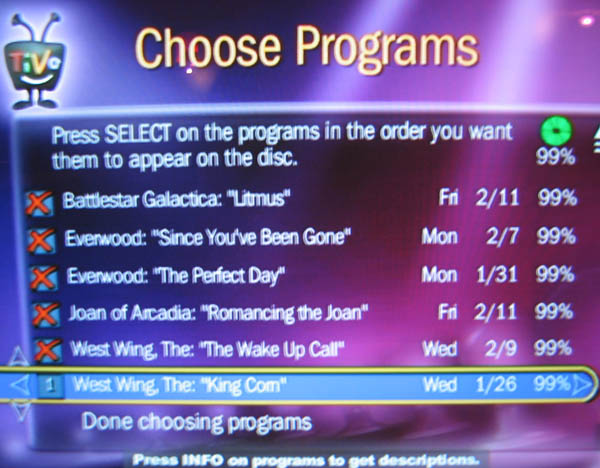
You can check these off, but once the disc has programs assigned to it, the ones others on your TiVo that are too big to fit on the DVD get an X next to them and you can no longer choose them. The other way to do it is simply to go into your "Now Playing" program listing, pick one of the progams, and choose "Save to DVD or VCR" after which you have the option to pick additional programs if you choose.
How do the programs look once they are on DVD? TiVo units actually have slightly different recording qualities depending on which unit you buy. DirectTV units (which are satellite receivers with a TiVo built in), actually record the original digital signal from the satellite. There is no conversion from analog to digital and/or visa versa. It is a digital stream that is recorded digitally to the hard drive, so there's no loss of quality. So-called "stand-alone" TiVo's get fed an analog signal (that was either converted by a digital satellite receiver or a digital cable box, or was never digital to begin with) which it then has to convert or even reconvert into digital. With each conversion, there is additional chances for degradation of quality when compared to the source. Finally, with the DRT-800, there is yet another difference. The DRT-800 records shows in a format that's a little different from other TiVo's, a format that's compatible with DVD's. This type of recording, like the regular TiVo recording, "compresses" the original video source so that it will fit in a smaller space. In essence, the conversion makes shortcuts by creating equations that estimate colors and movement. One can set these shortcuts to be more aggressive and end up with a program that takes up less capacity on the hard drive of the unit, but by being more aggressive, the recording cannot be as accurate in some circumstances (such has subtle color shifts or lots of motion) and so you get "artifacts" (typical signs of digital compression) that make the quality of the image seem poorer. The DRT-800's recording format looks to many like it is a bit poorer in quality still than a stand-alone TiVo's, at least for the lower-quality settings. For the best quality, it seems more or less equivalent.
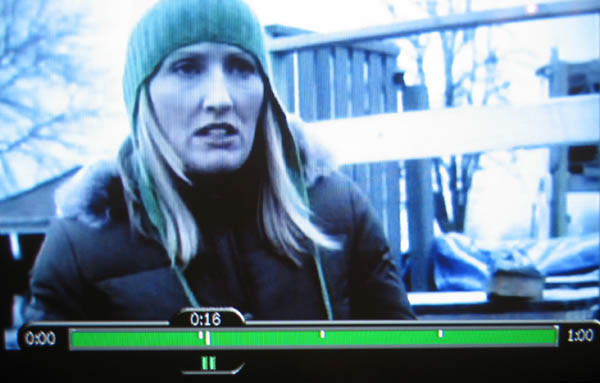
(This is actually a TiVo program that has been saved to DVD and is playing back on the DRT-800)
I keep mentioning space and capacity, and that is always on the mind of TiVo owners unless they have some mammoth 700-hour TiVo that they've custom built. Luckily the DRT-800 has what is effectively an unlimited storage capacity limited only by how many blank DVD's you can affort to buy. Storing TiVo programs on DVD, though, can sometimes be a little tricky in terms of the space needed – which also depends on the quality setting that you used to record the given program. If you record programs in "Best" quality, then you will only be able to record an hour's worth of programming per DVD. So movies will generally require at least two DVD's, and sometimes three or even more! This is one reason why I generally don't record movies onto DVD. It takes up too many discs at a decent quality level, and this makes it inconvenient to have to switch DVD's in the middle of playback. The other reason I don't record movies is because I have been spoiled by movies on actual commercial DVD's. Not only do you not get the nice menu, the various special features like commentary tracks, etc., but also the quality of recordings on the DRT-800 even at the best level isn't nearly as good as a DVD, at least if you are viewing one enahced for widescreen TV's on a wisdescreen TV. I happen to have a widescreen TV, and while not humongous at 34", it is still large enough to see a big difference in quality. One of my biggest issues with the DRT-800 is how it records movies that are in widescreen. Let me explain:
Aspect ratio (ie picture view dimensions) for TV's is either 4:3 (the old standard) or 16:9 (The newer "widescreen") Widescreen conforms more to what aspect ratios movies are filemed (or recorded) in. Widescreen TV's are also invariably high-definition. When a DVD comes out of a movie and is available in "Widescreen" – this refers only to hwo it is formatted on the screen. In order to actually take advantage of the added resolution of Widescreen TV's, it needs to say "enhanced for Widescreen TV's" on it. If it doesn't, it is simply "letterbox." Letterbox refers to the bars on the top and bottom of the screen that one sees when watching a widescreen movie on a regular TV. That wide image doesn't conform to the dimensions of the TV, so in order to fit the entire image, it needs to shrink it enough and doing so produces those bars. However, with a Widescreen TV, you SHOULD be able to see the entire image and have it cover the entire screen. But if it is not "enhanced" it simply shows the same letterboxed image formatted for a regular TV, and because you are viewing the image on a widescreen TV, not only do you get the bars on the top and bottom, but also on the sides! Now, Widescreen TV's do have a way to compensate this. It let's you "zoom" in on the image that takes up just a part of your screen so that it takes up the entire screen. However, this zooming doesn't really do anything to the inherent QUALITY of the picture. It just magnifies it, and in doing so you still are working with the same smaller image but just blown up more so that imperfections are more visible. With a truly enhanced for widescreen DVD, the image takes full advantage of the wider aspect ration of the image, producing a higher-resolution image that is MUCH better than the alternative.
I'm not sure how regular TiVo's record widescreen (high-def) programming. With the DRT-800, though, you can make such recordings. Of course, they will not be recorded IN high-definition, BUT, they ARE recorded in widescreen format. I'm fairly certain that this format is more or less equivalent to a DVD that has been "enhanced for Widescreen TV's" because the quality is quite high, almost has high as a DVD, but not quite. The problem comes in when you want to take that recording on the DRT-800's hard drive and transfer it onto a DVD. You would think this would support such widescreen formats, but it does not. When recording to a DVD, the DRT-800 takes that widescreen image and squeezes it into a standard 4:3 window that a non-widescreen TV would use. The result? That same image that DVD's that aren't enhanced for widescreen TV's produces – black bars framing the entire image. I've contacted Humax about this issue and while they didn't seem to understand the problem initially, they eventually just said that at the moment there's no solution for the problem. Let's hope that this changes, but somehow I think we might need to wait for a high-definition version of the DRT-800 for a real resolution.
Of course, recording regular non-HD, non-widescreen shows off of TV works fine, and since most shows are an hour or even a half hour, you can easily fit one or two shows at the best quality rating on each DVD. Unfortunately, you cannot span multiple programs onto multiple discs. So say for example that you have three 40-minute shows that you want to group together onto as few discs as possible. The DRT-800 cannot take those three shows and record them onto two DVD's. The only way you can span something onto multiple discs is if it is just one program that takes up over an hour. This lack of flexibility is a bit of an annoyance because it means you may be forced to waste a lot of disc space that could otherwise be saved. But, lets say you don't really care about the quality so much as wanting to capture as many shows on one DVD that you're going to be taking with you on a trip. Well, in this case, you can get as much as 6 hours of programming on one DVD by setting the quality level down to the lowest "basic." If you can't stand the quality at that level, you can also fit a couple of hours on the second-to-highest "high" quality, or 4 hours at the next to lowest "medium" quality.
The DRT-800 can record at speeds up to 4X. This speed rating is based on how much data can be written per second. DVD-R's or DVD-RW's that are rated at higher speeds than 4X won't do you any good – the recording will still be made at 4X speed. A Best quality recording that takes up 1-hour theoretically should record in ¼ of "real" time, or 15 minutes. In my tests, though, it's less – as little as 9-10 minutes. Since I don't record at lower recording levels, I can't say whether lower quality recordings differ, but logically it would seem that it should be the same to record a full DVD of best quality recordings as a full DVD of lowest quality. Of course the lowest quality DVD as I said would contain six hours of programming as opposed to one for the best quality, so you could view this as being able to record 10 minutes per hour as opposed to less than two minutes per hour depending on the quality setting.
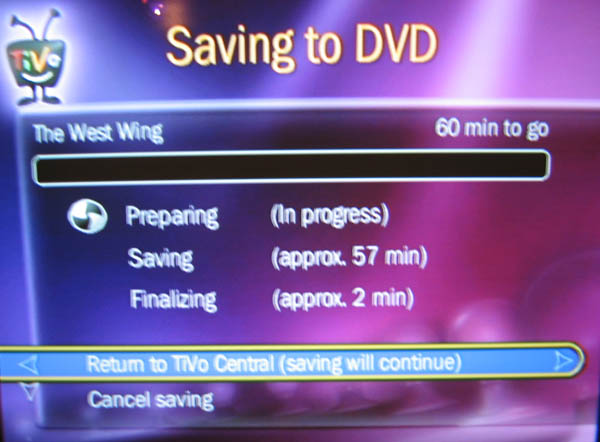
(As you can see, when first starting to record, it looks like the process will take 60 minutes)
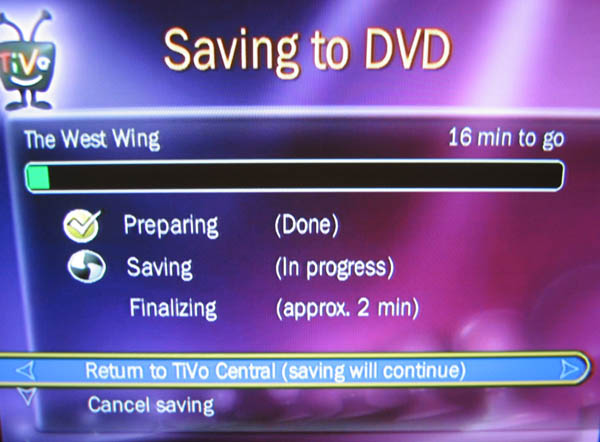
(However, very quickly the system corrects itself and modifies this estimate to be much more accurate)
The other nice thing about recording DVD's is that you can do this in the background. Regular TiVo's have a certain ability of multitasking already – you can watch a recorded show a the same time that another show is being recorded. And with dual-tuner units (so far these are only available in DirectTV Tivo's) you can do the same thing that VCR users have been able to do for years – watch one channel live while you record another – or something that a single VCR has never been able to do – record two channels simultaneously. But like regular stand-alone TiVo's, the DRT-800 only has one tuner. But at least you can record shows to DVD, record a live show, and watch a recorded show all at the same time, and in my book that's pretty darn good!
Recording from other sources: one thing about the DRT-800 which I think is underated is its ability to record from any input source. Yes, other TiVo's can record from a VCR via composite inputs, but the DRT-800 adds additional functionality to this by also offering S-Video and even Digital Video (via 1394 AKA Firewire) inputs as well.
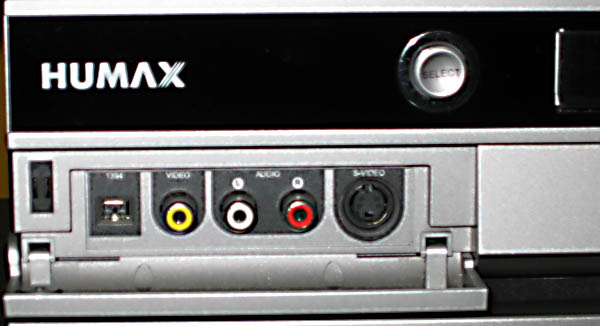
(front inputs from left to right - DV (1394), compsite video, composite audio, S-Video)
The Digital Video input is the most important as it allows for a direct digital to digital recordings. As an added convenience the DRT-800 offers these inputs on the front of the unit as well as the back. I don't have a digital video camera myself yet, so I could not test out this type of recording, which I assume would happen at a very rapid speed. What I have done, though, is hooked my VCR up to the composite inputs and recorded some old home videos. You can specify how long the recording will be, and I found it's best to overestimate because then you can manually hit the stop recording button at exactly the right end point. Once you have made the recordings onto the hard drive, of course, that's where it would end for a normal TiVo. But with the DRT-800, this functionality really proves itself useful because you can then go the extra step and record it onto DVD. For old VHS recordings, this is a real lifesaver. As analog tapes are played each time they degrade a little, and there's also some degradation over time whether tapes are actually played or not. So it is vitally important if you want to hold onto these memories without such degradation of quality, that they get recorded onto a more permanent digital medium. How long DVD's themselves will last is up for debate, but probably by the time they do start to fail, there will be much more advanced digital media formats that allow for both more capacity as well as longevity. The one catch to recording from an external source that's not your TV is that for some reason TiVo can't handle doing anything else during the process. So if are going to record your old two-hour VHS tapes, you basically will have to go use another TV if you want to watch something during this time. Not particularly convenient!
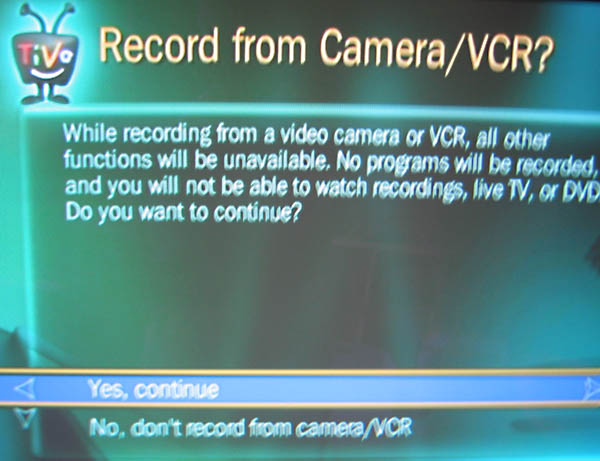
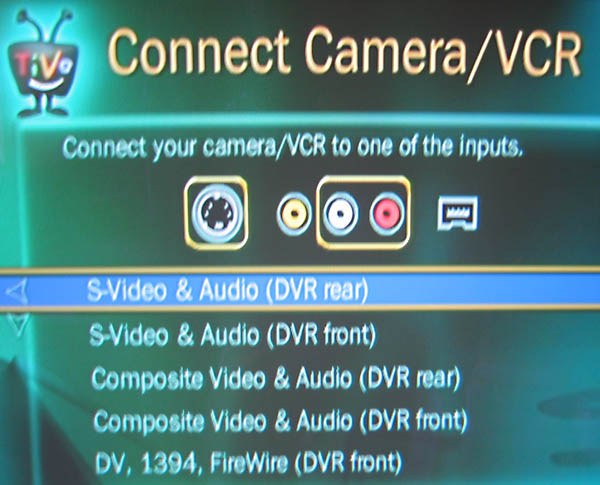
When playing back shows you have recorded onto DVD, you actually get a standard menu interface that looks very much like the TiVo environment. This makes things very easy on the one hand, but on the other hand some will find it a bit limiting to not be able to customize the disc very much. One can actually rename any program so that it shows up that way in the menu, but once you "drill down" you are still presented with the program title and description as you would on the TiVo. The other annoyance is that when you are recording an episode of a series, the default name given to the DVD is the name of the series itself, rather than the name of the series followed by the episode name. Having the episode name would be more useful, but frankly the added effort to enter that into the title is too much of a hassle for me to want to do for every recording I make. When you are recording old home videos, the impulse is to take advantage of the menu capability and to record different parts of a video as different "chapters" within the DVD. This doesn't really work like DVD chapters per say, because they show up as completely separate programs. They don't just play one after another. Once one is done playing, you have to manually navigate to the next to have it play. I'm sure things are infinitely easier with a digital video camera that one can simply transfer the video to a computer and index it at the appropriate points or even cut it up into separate files before finally burning it to a DVD.

(As you can see, the DRT-800 provides a default name for recording a DVD, which is convenient, but could be better - only the series name is provided, not the individual episode name)
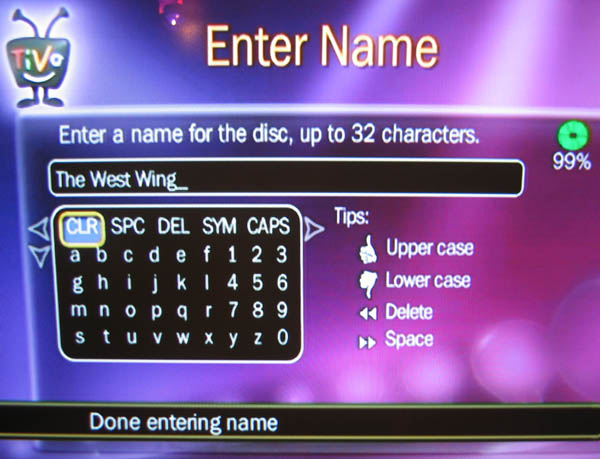
(of course you can add additional text, but it's not as easy as typing on a computer, so especially for a longer episode title, it's just not worth the bother if you record a lot)
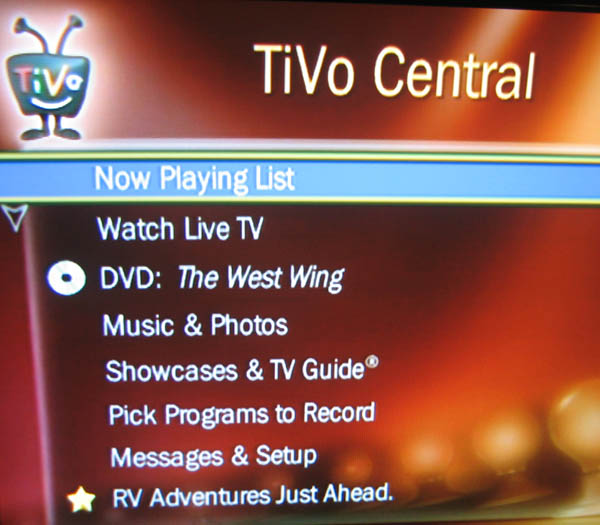
(once you record the DVD, it's title will show up in the main TiVo menu, and as you see here only the title of the show is visible)
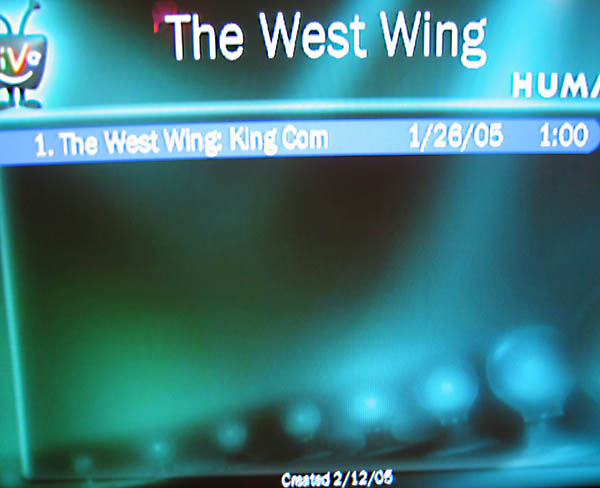
(once you actually go into the DVD, you see the full show and episode title)
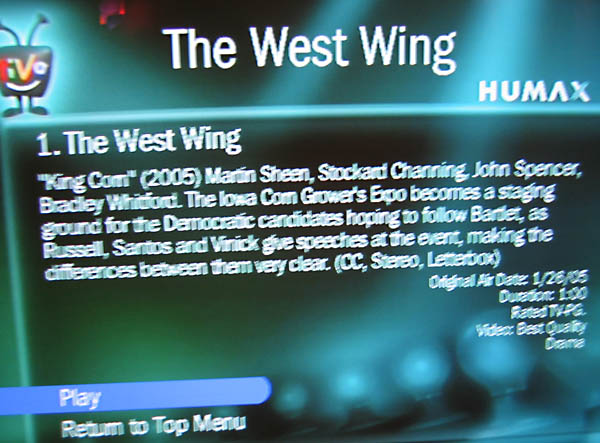
(just as in the regular TiVo interface, the menuing on the DVD provides synopsis of the episode, and information on when it was recorded, how long it is, etc.)
Conclusion:
I bought the DRT-800 for a number of reasons. The ability to archive TV shows without having to worry about running out of room on the hard drive of the unit was one factor – and doing this without having to deal with upgrade kits and added expense was very convenient. In addition, the ability to save old videos to DVD's for me was key. I have a PC laptop and it does not have video inputs that would allow me to record from video sources and then make these digital files that I could later burn onto a DVD. The simplicity of this solution is great, even for someone who is used to this sort of technology because it just means that you don't have to spend as much time. It's of course not as flexible as other solutions, but for people with busy lives and not extremely demanding requirements for video editing, it's ideal. For those who need high-definition quality, as well, the DRT-800 will not get you there. There are TiVo's that do HD, but they are all around $1000 and none come with a DVD player/burner built-in like the DRT-800, although eventually this will all change of course.
Epilogue –TiVo ToGo: You may have heard of this new feature that TiVo unveiled just a few weeks ago called TiVo ToGo. It allows those with TiVo to transfer their recordings to a computer. The one question you might have is, does this new feature make a unit like the DRT-800 obsolete? In my opinion the answer is no. When I bought the DRT-800, I knew I was kind of taking a gamble. At that point, there had been talk of TiVo ToGo for a good 10 or 11 months. I felt like I couldn't count on this feature showing up any time soon given the fact that it had been talked about for so long but not delivered. Now that it is here, I still feel like I made the right decision and here's why: While TiVo ToGo does allow you to record TiVo programs to your computer, the process is not nearly as fast as recording a DVD on the DRT-800. One has to transfer the file over a USB 1.1 connection, which means a considerable length of time. Even once it's transferred, it still is sitting on your computer and not on a DVD. Unless that computer is a laptop, you haven't made that recording much more portable than it was on your TiVo. If you want to then burn it to DVD, you have to purchase an additional application from Sonic and this will still mean additional time to burn the DVD. In addition, the transferring and/or burning takes a lot of processing power from your computer, which is a hassle if you want to be doing other things with it as well. The one gotcha about TiVo ToGo as it relates to the DRT-800 is that TiVo is not offering it for models with DVD burners until some time in the future that's not been determined. This does make some sense because for those with TiVo's with DVD Burners, the need for TiVo ToGo itself is not really there – it's redundant. The problem is not so much with TiVo ToGo itself, but rather with the other features that come along with the version of the system software that enable TiVo ToGo. Namely there is the so called "Home Media Engine" or "HME", a system for third-party developers to create all manner of applications to work with TiVo's. These applications can be installed simply by the user without any hacking or serious technical expertise, unlike the applications that have been developed in the past but required some serious hacking of TiVo hardware and software. None of these HME applications are available to DRT-800 users until TiVo deems it time to update the system software for TiVo's with DVD Burners. Hopefully that will not take months and months, but who really knows?
posted Monday, 14 February 2005
![]()
![]()